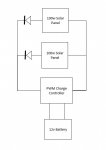ctva
Well-known member
At present I have a 100w panel on one side of the boat where the spray dodgers usually are. This is fixed and gives between 5A and 1A in full sun depending on whether the sun is on that side or not. I am looking to add a second panel on the opposite side so one will always be in the shade (no other mounting options) but one will always be in the sun. At present I have a 10A PWM controller.
Panel -
Peak power: 100W
Maximum power voltage: 19.3V
Maximum power current: 5.18A
Open circuit voltage: 22.9V
Controller - 10A Solar Controller (Photonic Universe)
With the configuration, will I need to up to a 20A controller (current 10A says does up to 160W) but with the panels being back to back will the current 10A one do?
Secondly from what I have read, it would be better in parallel due to the shading but where I'm confused is the benefits (if any) of getting a MPPT over the cheaper PWM controller for this set up?
Any thoughts would be appreciated.
Panel -
Peak power: 100W
Maximum power voltage: 19.3V
Maximum power current: 5.18A
Open circuit voltage: 22.9V
Controller - 10A Solar Controller (Photonic Universe)
With the configuration, will I need to up to a 20A controller (current 10A says does up to 160W) but with the panels being back to back will the current 10A one do?
Secondly from what I have read, it would be better in parallel due to the shading but where I'm confused is the benefits (if any) of getting a MPPT over the cheaper PWM controller for this set up?
Any thoughts would be appreciated.


